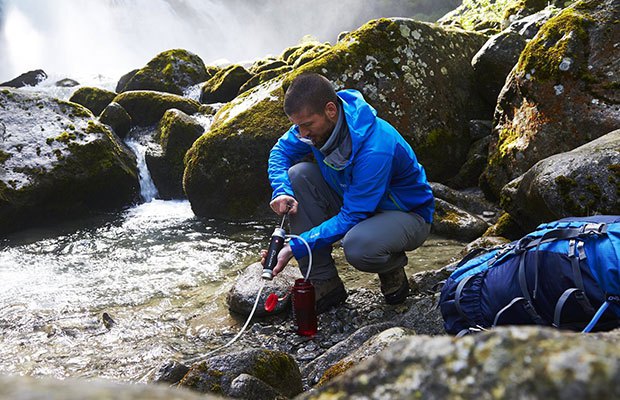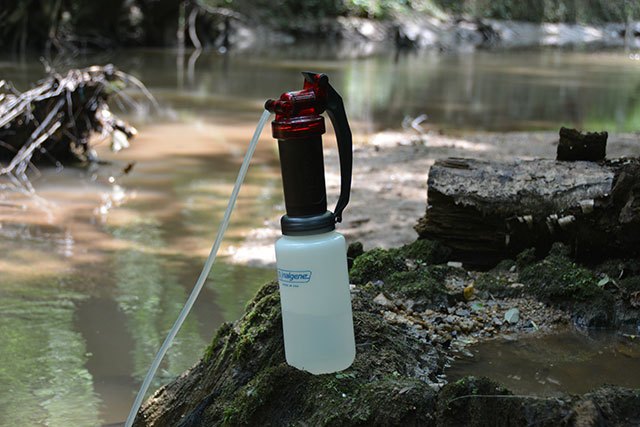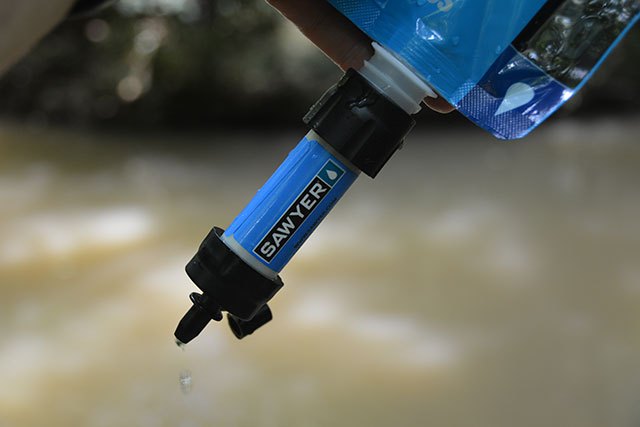Bug Out Bag Water Filtration Options
A critical prep that you have to plan for including in your bug out bag is water. When I first got into prepping, I had people saying that they would carry all of the water they needed in their bug out bags. If you figure 3 gallons (1 gallon per person per day), that would simply not be wise or possible for most people for very long. Then I started seeing people say they would pack 3 liters of water. That’s better, but 3 big plastic bottles is almost 7 pounds, not to mention you must have space for them. Not the end of the world, but not insignificant either.
One of the ideas I try to promote is to watch the weight on your bug out bags and not overload them. I recommend this for a lot of really simple reasons. If your Bug Out Bag is too heavy, it will hurt eventually. It might not hurt when you first take off walking, but it will eventually. In addition to rubbing you raw and potentially causing injury, you will be more off-balance and less able to quickly move. If you can’t move out of danger quickly enough, that bug out bag could get you killed. The better idea is to pack your bug out bag in a way that is as light as possible while still maintaining the essentials you need to survive for up to 72 hours. Don’t go minimalistic for the sake of making the scales proud, but you should look carefully at the overall weight.
Water, Food and ammo, possibly a tent are all great places to shed pounds from your bug out bag and today we are focusing on water. I have personally tried a few different water filtration methods and wanted to highlight the pluses and minuses for you today on Final Prepper as I see them. Hopefully this information you will make sure the bug out bag water filtration options you choose will work well for you if you ever need to use them.
In addition to being less heavy than simply carrying your water on you at all times, these bug out bag water filtration options will give you increased range and capabilities. Instead of being limited to only the water you are able to carry, it is easy to filter an extra liter or more from sources along your route. All the while, ensuring that the water you are drinking isn’t going to make you sick.
MSR MiniWorks EX Water Filter
This first filter I tested is one I have owned for years and up until recently used on my backpacking trips. The MSR MiniWorks EX is a great water filter that is activated by a manual pump. You simply connect the hose, stick that into the water and screw your Nalgene bottle or dromedary bag onto the bottom of the filter and start pumping. In just a few minutes the water from your source will be pressed through the filtration system and with a little time, you will have a full bottle of clean water to drink. Filtering a standard Nalgene bottle like below probably took 3-4 minutes.
The MSR MiniWorks EX was my first backpacking water filtration. We loved it when we had to depend on it in the woods.
I would take these down to the river and fill up everyone’s water bottle as well as two 48 ounce bladders we had when we stopped. The bladders were to refill bottles and went toward coffee and reconstituting our freeze-dried food.
So, good and bad about this filter. First off, I like the fact that this is pretty simple to use and you don’t have to get down into the water to collect anything. The water tastes great and the pump has stood the test of time for the most part. I did have one pump stop working on my wife when we were on a backpacking trip. Fortunately, I had two filters so we had some redundancy built-in. Pumping does take you a little while and the pump isn’t the lightest or cheapest option. Once you return from your trip you need to clean the filter element, usually with a scrubbing pad to get the gunk off of it and let everything dry completely for a few days before you put it away.
MSR MiniWorks Features
- Ceramic/carbon Marathon™ EX element effectively removes bacteria and protozoa including giardia and cryptosporidia
- Also removes unpleasant tastes and odors caused by organic compounds, such as iodine, chlorine and pesticides
- Filter can be cleaned over and over for maximum field life with no tools required
- Bottom screws onto an MSR Dromedary® Bag or Nalgene® water bottle for easy operation (both sold separately)
- Easy dis-assembly lets you troubleshoot and maintain the MSR MiniWorks EX filter in the field
Weight: 14.6 ounces
Cost: $84 on Amazon.com
I also found this excellent review of the MSR MiniWorks EX from Black Owl Outdoors for those who like to watch videos.
Sawyer Mini
When I first tried out the Sawyer Mini I thought this was the best invention in the world at least from the standpoint of water filtration options for preppers. The filter was extremely lightweight, compact and could filter hundreds of thousands of gallons. The Sawyer Mini could be used as a straw to drink from a water bottle like the life straw or from the included squeeze bag that comes with it.
The cost, low-weight and ability to filter so much water is an incredible advantage, but using either the squeeze bag or a standard water bottle has some drawbacks in my opinion. You are still only filtering on demand unless you squeeze the water into another container and that isn’t always the most practical. One of the reasons I don’t think the LifeStraw is the best option for me in all cases.
You can use the included squeeze bag to collect water and the Sawyer will make it safe to drink.
Sawyer Mini Features
- Hollow-fiber membrane offers a high flow rate; sip on the Mini like a straw and it filters the water while it’s on the way to your mouth
- Filter will also fit the threads on the included Sawyer 16 fl. oz. reusable pouch that you can fill at a lake or stream and then use to squeeze water through the filter
- 0.1-micron filter physically removes 99.99999% of all bacteria, such as salmonella, cholera and E.coli; removes 99.9999% of all protozoa, such as giardia and cryptosporidium
- Filter will also fit the threads on most bottles of water that you buy at a grocery store; can also be used as an inline filter (adapters and hoses not included)
Weight: 2 ounces
Cost: $20 on Amazon.com
I also found this review for perspective from Preparedmind 101
Polar Pure – Crystal Iodine Water Treatment
The third option I tried is Polar Pure. Polar Pure is a Crystal Iodine water treatment, not a filter. The bottle holds actual iodine crystals you might be able to see in the photo below. The process is for you to fill the bottle with water and let this sit for 1 hour. At the end of an hour you have something like concentrated iodine brine that you can use make almost any water safe to drink. There are simple to follow instructions on the bottle and even a hand-dandy gauge to tell you how many capfuls of the solution your water will need to be safe. The number depends upon the temperature of the water.
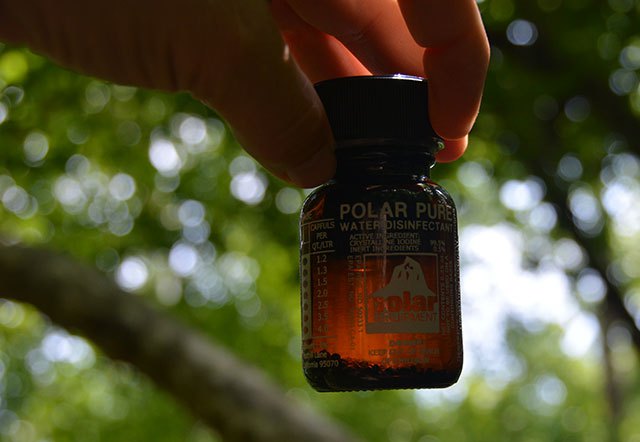
Polar Pure uses iodine crystals to disinfect water.
You pour the recommended capfuls into your 1 liter water bottle and let it stand for 20 minutes before drinking. When you are done, just fill the bottle up with water again and it will be ready for your next treatment in another hour. This relatively small bottle will last for up to 2,000 liters of water, although I don’t know who would count them. When the iodine crystals are gone, so is your ability to use this to make your water safe.
Iodine, unlike the micron water filters above can kill viruses. Giardia, mentioned above is caught by the water filters, but if you have something like hepatitis or polio in the water, the simple filtration method above won’t work. Now, the question becomes, do you have to worry about viruses in the water you are drinking or just organisms that can make you violently ill?
The Polar Pure bottle is one that I would carry with me as an extreme back up for highly questionable water. The science is good on making your water safe. Iodine has been used for a very long time, but the bottle is glass. You could be in trouble if this is all you have and it is broken. Additionally, iodine will make your water safe, but it won’t filter it out so if you pour yourself a big cup of slightly brown pond water and treat it with iodine, it will be perfectly safe for drinking – brown pond water. Filtering your water first through a handkerchief or something like coffee filters at a minimum would be better. Some people use Polar Pure plus another filter for the ultimate in safe water.
Weight: 5 ounces
Cost: $20 on Amazon.com
For those who want to see the polar pure in action, there is a good video from Provident-Living-Today.com
Platypus 2L GravityWorks Filter
The last item I tried out for my bug out bag water filtration decision process was a relatively new purchase. I had heard about the Platypus GravityWorks Filter system from one of the readers on Final Prepper when I was initially looking at the Sawyer answer to the same functionality. The Platypus was almost half the price so I decided to give this a try because it looked like the perfect solution to me.
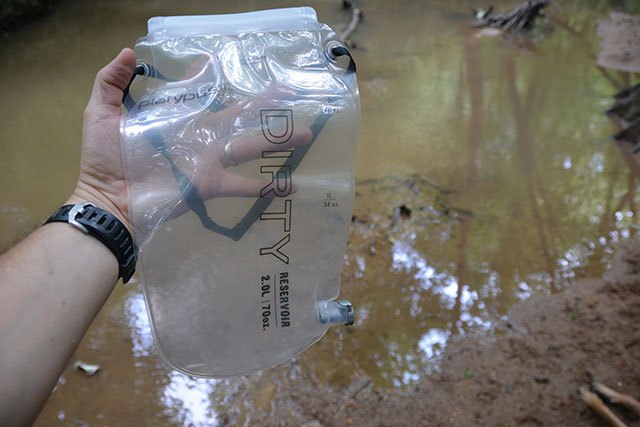
Keeping the bags separated is easy with clear labels.
The Platypus 2L GravityWorks Filter is a two bag system. You have one bag for water collection and it is very simply labeled “Dirty”. Your dirty water goes in here and it has a wide opening at the top which works very similar to a zip loc bag. This wide opening allowed me to collect 2 liters of water from the creek very quickly and easily. You can see my test water isn’t a crystal clear glacier spring so the bag’s label was very appropriate.
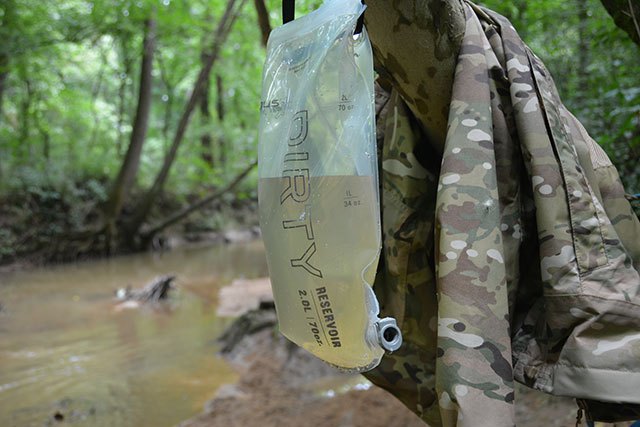
The Platypus Bag system has a simple attachment system to hang your bag of water to be treated up on a tree, bumper or anything higher than the clean bag. Gravity does all the hard work.
Another nice feature were the connectors. The Platypus GravityWorks has a quick connect so you can collect your dirty water and either pack it out for filtration later or carry it back to camp. The filter element snaps in and you are ready to filter.
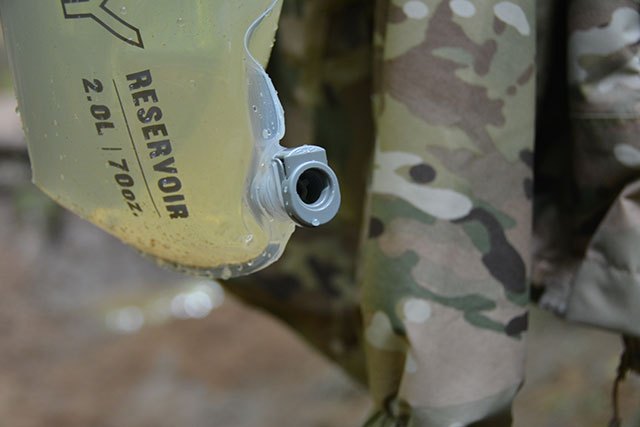
The Platypus filter element snaps into the reservoir quick connect and you are all set to filter water.
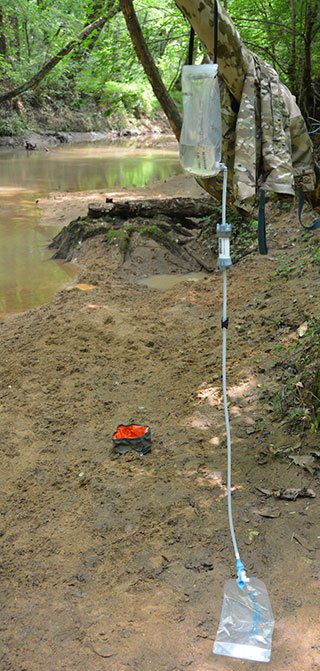
This system is fast. I only filled up about 1 liter but it was filtered in less than 2 minutes.
Once the filter is snapped in, the water will flow almost immediately. The tube running from the filter has a stopper that you can use to quickly pinch off the flow while you hook up the clean bag. As long as the bag of dirty water is higher than the clean bag, the appropriately named GravityWorks filter will take care of all your heavy lifting while beautiful clean water flows into your empty bladder.
This system will hold 2 liters of water which I think gives you a lot of water for the average person. You can also just filter two liters, then collect two more liters of dirty water for later. You will be carrying four liters of water with you at all times. Two filtered and two that needs to be filtered.
Cleaning this system is as simple as lifting the clean water bag up over the dirty water bag and squeezing your clean water bag. You will see the dirty sediment flow back into the dirty bag and you know your filter is clean when that stops.
Platypus GravityWorks Filter Specs
- Easy, Pump-free filtering
- Fast! 1.5-liters per minute
- Weighs as little as 7.2 oz. (203 g)
- Ultra-Compact
- Meets all EPA & NSF guidelines for the removal of Bacteria and Protozoa, including Giardia, Cryptosporidium, E. coli, Salmonella and Cholera
Weight: 7 ounces
Cost: $79 on Amazon.com
And I found this review from Outdoor Gear Lab that shows the larger 4 Liter system.
So What is the best bug out water filtration system?
This question isn’t something I can answer with a definitive statement that will stand for all time or in all situations, but I will share some of my thoughts. My idea of bugging out involves living possibly for some time in forested terrain. I plan to be on the move and I don’t want to slow down more than I have to for rest. Water is crucial for life so I don’t want to have to go to more trouble than is prudent to acquire it. Additionally, if I am strapping a pack on my back and walking out the door, I have to plan for being on my own so to speak for potentially much longer than 72 hours.
I have considered both caplets like the Portable Aqua Water Filter tablets and I even own some of them, but they last for a finite amount of time. The standard bottles will give you I think 25 quarts of water. With a hike for three days in the summer, enough for food and your bottle will quickly be cleaned out. It will go faster if you are sharing.
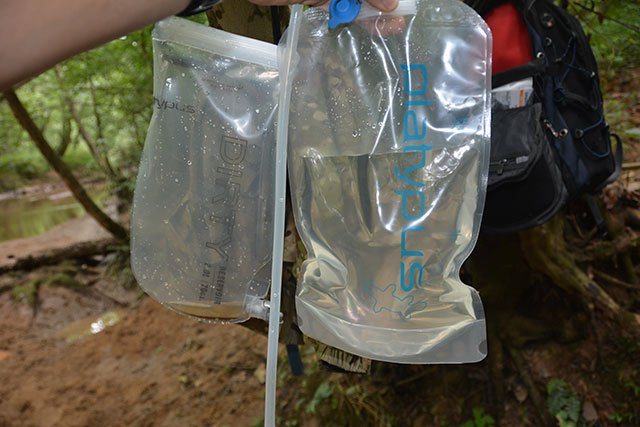
I had all of this clean, fresh tasting water in a little less than two minutes.
The LifeStraw product is one I just don’t think is practical. It is a great idea, don’t get me wrong, but I for one don’t want to be forced to stick my head in a puddle just to get a drink. I want to take giant gulps of water if I am thirsty and I want to be able to take water along with me. Sure you can fill up empty bottles and drink out of them with a LifeStraw, but I think there is a better option.
The MSR Filter pump has usually been a great filter, but because it is mechanical, I have had one give me troubles. I was able to repair it eventually, but that wasn’t a good sign. I should have back-ups anyway I know, but I would rather go with a more stable platform and the MSR is heavier than all of the other options I have tested.
What about boiling water? Sure you could do that, but you have to build a fire first and then boil your water, then let it cool down. Do you want to do all of that in the heat of summer? Even in winter, that fire might be nice, but to go through all that effort for drinking water seems like a fall back plan, not the first option.
Iodine crystals like Polar Pure seem to be the best option for killing viruses, but like I said, their bottle is glass. One slip out of your hands onto a rock will end your water filtration options for that bug out trip. Even if you don’t drop it, I prefer to drink water as soon as possible and wouldn’t want to remember to keep my iodine warm for effectiveness. I think Polar Pure makes sense as a back up, but not the sole method of water filtration in a bug out scenario. For Backpacking trips Polar pure is a great idea. If you have the time to leisurely prepare your water, I think this is a good option.
The Sawyer as it is would probably be my second choice because of the weight and size. I would have to fill a large reservoir, something like the 48 ounce Naglene Bladders and rig up some way to squeeze filter a larger amount of water into my bottles. Not the best, but it is incredibly light and could get the job done.
What about items like the SteriPEN that use UV light to make water safe to drink? What about EMP? What if it breaks? What if you run out of batteries?
I think that for me the GravityWorks system from Platypus is the easiest and fastest way to collect water that will be clean and fresh tasting. With it’s fast flow rate, I can grab a 2 liter bag of water, hook up the filter and throw them both in my bag if needed and keep on going to a safe location. This seems to offer the most capacity with the fastest filtration time and easiest system to learn and remember. I can teach my kids how to use this in about 2 minutes which is about the same amount of time it takes to produce 2 liters of clean water.
That is my take on the best bug out water filtration options. What do you use?
A critical prep that you have to plan for including in your bug out bag is water. When I first got into prepping, I had people saying that they would

